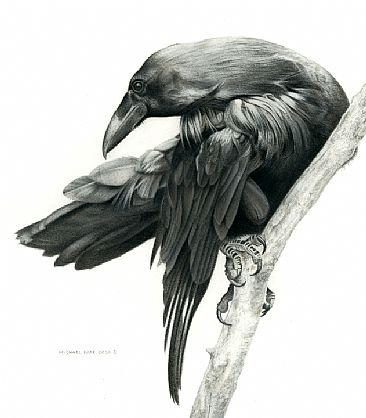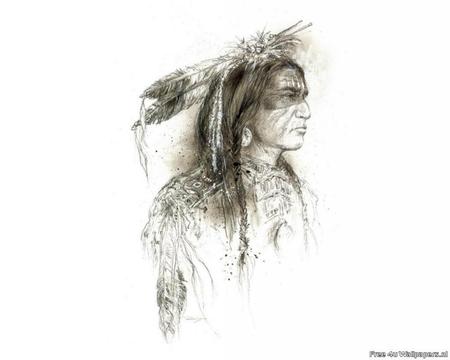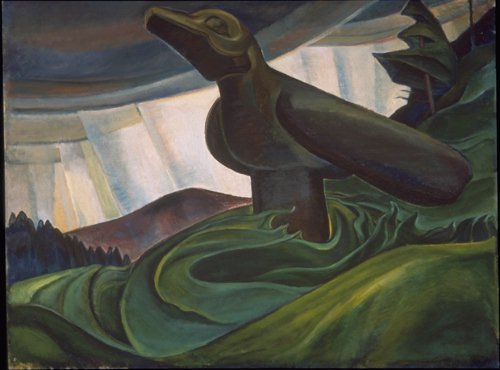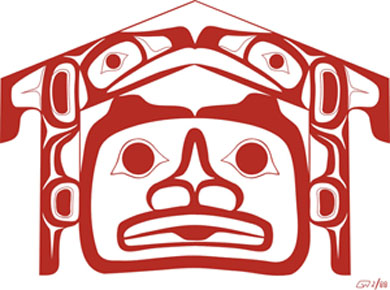Way back before all our time, there lived a Raven. The Raven was the only intellectual on mother earth who could speak. As you can imagine, the Raven got quite lonesome. He would spend his nights prowling the forest to find a friend, but all the animals were sleeping. He would spend his days flying above the rivers and flat lands searching for a friend, but all the animals were busy hunting and making homes for their young.
One day, when the Raven was resting on a rock by the river, he noticed a bear. The bear was focused, paw in the air, getting ready to strike down and retrieve the most delicious sock-eye salmon. Raven tried to talk to Bear but Bear wouldn’t respond. Bear was hungry, Raven thought. So hungry he didn’t have time for Raven.

After Raven flew off from Bear, he landed himself in a grass clearing. As soon as Raven landed, he heard a growling. “Where is this growling coming from!” thought Raven. He searched all around the grass field but could not find a single animal. Then, as Raven looked into the forest, he saw many pairs of yellow gleaming eyes. He yelled, “hello! I come in search of a friend.” The animals then came walking out of the forest, slowly and carefully. They didn’t say a word, they just kept on inching closer and closer to the Raven. Just before the wolf pounced towards the Ravens direction, Raven jumped in to the air and flew far far away.
Raven flew far away from land, towards the sun. He flew until he no longer could see land and was surrounded by waves of liquid blue. He found a small island and decided his wings needed a rest. Raven was so exhausted, he collapsed onto the beach and fell asleep. He started to dream while he was sleeping. Raven dreamed that he was the creator of all mother-earth. He created an animal called Man. In this dream, Raven taught Man how to fish, make a home, and stay warm. They were the best of friends. Raven woke up and found himself still on the island in the middle of the ocean. Raven wanted to go back to sleep and find his dream again, but Raven was hungry.
He flew back to land and was about to find a place to fish, when he noticed a strange animal he once saw somewhere. Curious, the Raven flew closer to land to get a better view of this strange animal. Aghast! The Raven stumbled out of the air and landed next to Man. Raven asked Man how he got to mother-earth. “Silly Raven, you created me.” Raven was so happy, he took man into the air with him and flew in a joyous celebration.

Raven and Man became best friends. They were never seen one without the other. Until one day, when Man decided to go for a walk while Raven was sleeping.
Man wanted to see the world without Raven. When he left the warmth of the fire, he decided he needed something to keep warm with. Man stumbled across a mother bear trying to protect her young, he realized that his life, for once, was in danger. He won the battle somehow. Man looked down at the bears body and thought if only I could have fur like the bear. So, Man took a sharp edged stone and carved away the bears fur. He wore this fur and was kept warm.
Man was hungry after his battle with the bear, so he decided to eat some fish. After eating a salmon, he was still hungry. So Man found some berry bushes and ate every single last one of them. He was so full, Man needed a nap.
Man was woken up to angry chirping. When he opened his eyes, he had to duck so he wouldn’t be hit by the diving bird. The birds were angry at Man for eating all their berries, where could they find berries to feed their young?
Man didn’t care. All he cared about was how hungry he was. He thought the birds looked awfully scrumptious. The next time the bird dived down, Man grabbed the bird and killed it. He built a fire and cooked the bird, just like how Raven taught Man to cook his fish. Bird was good! Just as good as fish.
Out of this, Man’s lust for new food was born. He wanted to try everything. And he did. He traveled far and wide to try new food. He tried different land animals such as deer and moose, vegetables (but man didn’t like the taste of those), different fish, and all the birds he could find.
Man thought he had tried all meat on the mother earth, until Raven flew down next to Man. Raven said, “Man, I have been searching everywhere for you my dear friend. My how fat you have gotten.” Man didn’t want to catch up with Raven, he didn’t want to tell Raven how he’s been eating all the animals. All Man could wonder about was how Raven tasted.
Man played along with Raven until it was bed time. Man created a fire, sharpened his stone, stretched his muscles, and lunged at the sleeping Raven…
——————————————————————————————————————–
I didn’t complete the ending of my story because I want my readers to imagine how it ends. The Raven, in some aboriginal mythology, is the creator of mankind. He creates man because he was bored. He needed something to entertain him. Once man was created, Raven would play tricks and games on man. In some aboriginal mythology, the Raven is not the creator, but called the Trickster. The Raven is always, for some reason, the being that causes evil. He tricks man into doing things that are crude and sadistic. My story plays along those lines, but with a twist. Man is evil. Man is consumed with greed for food. He becomes so consumed with his greed, that he lunges at his creator with hopes of killing and eating him.
I wanted to take Thomas King’s story away from telling a story within a story. I wanted to tell my story and have my readers finish the ending. King’s story about evil said that once the evil was told, you cannot take the words back. In my story, once Man was created, you cannot un-do the evil he reigned.
I would like to welcome all my readers to write their endings in my comment box. Then can I get a sense of how evil my readers think Man and Raven to be…

http://www.billreidfoundation.org/banknote/raven.htm
http://www.ravenfamily.org/nascakiyetl/obs/rav1.html
King, Thomas. The Truth About Stories: A Native Narrative. Peterbough:Anansi Press. 2003. Print.








